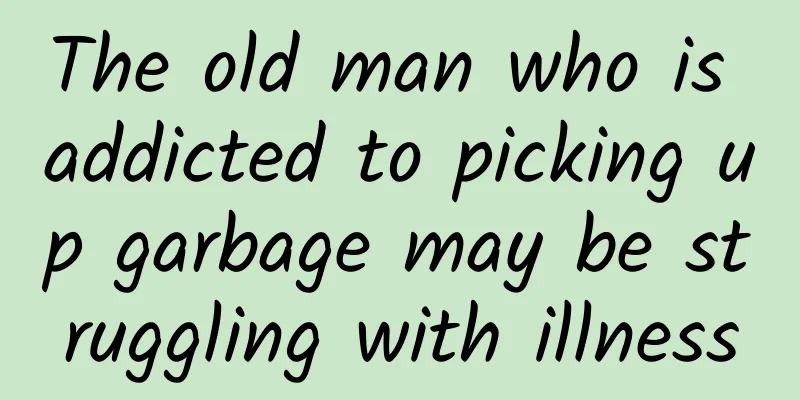The old man who is addicted to picking up garbage may be struggling with illness

|
From another perspective, collecting garbage may be a form of self-help. Written by | Kestrel In April this year, in Shanghai, which was under strict lockdown, an elderly man who was used to scavenging was exposed. He went to the trash can in the middle of the night and found a trash can that stored epidemic prevention waste, which caused him to be infected and spread it to others. However, the elderly man did not need to rely on scavenging to make a living, so many people around him were very angry and condemned the elderly man for being ignorant or vicious. In fact, such cases are not uncommon and are reported by the media from time to time. In 2004, a 70-year-old man in Guangzhou became addicted to collecting garbage, and the stench from the garbage in his living room bothered his neighbors; in 2006, an 85-year-old man in Nanjing collected garbage, and the stench affected nearby residents; in 2015, a 73-year-old man in Hefei had been collecting garbage for more than a decade, turning his home into a super garbage dump; in 2016, a 70-year-old woman named Chen in Chengdu filled her two-bedroom apartment with garbage and was eventually sued by her daughter... These elderly people were not forced to pick up and hoard garbage because of life. The case in Shanghai in April attracted special attention only because it occurred during the lockdown and caused serious consequences. Garbage collection is the key word in the above case. Let’s look at a slightly different case from the records of a psychiatric resident [1]: "Mr. F, 78, is a white (Caucasian) man with hypertension and coronary artery disease. Six weeks ago, he was diagnosed with sinus cancer that had metastasized to the leptomeninges. He was hospitalized for increasing difficulty swallowing, fatigue, and nosebleeds. During the history, his son mentioned that since learning of his cancer diagnosis, his father had begun to hoard garbage, rotten food, and fecal matter in their home. Mr. F lives alone, and his hoarded items have made his home crowded and messy." The hospital's psychiatric team concluded that Mr. F's condition could not be classified as any of the diseases defined by the current diagnostic criteria. He had no emotional attachment to the items he hoarded, nor did he feel the need for them, and he lacked insight into his hoarding. He felt a little depressed about his cancer, but not to the point of despair, and said he was willing to "live one day at a time." The mental status examination showed that Mr. F was friendly, cooperative, humorous, and had normal mood swings. His orientation, executive function, attention, memory, abstract thinking, naming, and language abilities were all intact. He had a successful career and worked in the automotive industry for more than 30 years before retiring. After retirement, he also founded a small business. Before being diagnosed with cancer, Mr. F did not have hoarding behavior. Although the cases mentioned above cannot be classified into any of the diseases defined by the current diagnostic criteria, they are more consistent with a historical disease called "Diogenes Syndrome". The name of Diogenes Syndrome was first proposed in 1975 and originated from Diogenes, an ancient Greek philosopher and founder of the Cynic school who lived in the fourth century BC. Legend has it that Diogenes "lacked a sense of shame", "despised social organization", and lived in a large barrel, as depicted by the French painter Jean-Leon Gerome (Figure 1). Therefore, Diogenes Syndrome was once used to refer to a special type of patient who usually had a high IQ and had a successful career, but after learning that he had a life-threatening disease (such as a tumor), he suddenly began to extremely neglect his own health and nutrition. However, many professionals do not support the idea of "Diogenes syndrome". They believe that "extremely dirty living environment" is the core feature of this type of disease. More specifically, patients with this type of disease extremely neglect their own hygiene and often hoard garbage, rotten food and even excrement. Figure 1. Diogenes as depicted by French painter Jean-Leon Gerome[3] However, Diogenes syndrome is not currently a clinical diagnosis. The disorder that most closely resembles Diogenes syndrome is hoarding disorder, which is characterized by a persistent difficulty discarding or parting with possessions, regardless of their actual value. Patients often become distressed when they are about to discard or part with their possessions. Hoarding disorder was only classified as a separate disease in the fifth edition of the Diagnostic and Statistical Manual of Mental Disorders (DSM-5), published in 2013. Previously, extreme hoarding was only classified as a manifestation of obsessive compulsive disorder (OCD). In fact, many mental and neurological diseases may have manifestations of "Diogenes syndrome" or "extreme hoarding". Therefore, the diagnosis of hoarding disorder is a so-called "diagnosis of exclusion", that is, doctors will only make a diagnosis of hoarding disorder after excluding other physical and mental disorders that may cause excessive hoarding of items. There are also the following types of diseases that may manifest similarly to hoarding disorder in clinical practice [2]. We roughly arrange them in order from strong to weak in terms of "organicity" (as opposed to "psychogenicity"): The first type is hoarding behavior caused by brain damage. The patient did not have hoarding behavior before the brain damage, but hoarding behavior began soon after the brain damage. The cause of brain damage can be trauma, cerebrovascular disease, or surgical resection for tumor treatment or epilepsy control, infection, etc. The second category is neurodevelopmental disorders, such as autism spectrum disorders, which may show hoarding behavior. The third category is neurodegenerative diseases. Excessive hoarding behavior may be caused by neurocognitive disorders related to frontotemporal lobar degeneration or Alzheimer's disease. Neurodegenerative diseases and neurodevelopmental disorders are relative concepts. Generally speaking, development is the process by which the structure of an organism changes from simple to complex. The central nervous system produces many nerve cells in the early stages of development, and some of these nerve cells form functional synapses during development and participate in cognitive construction. These developmental processes can be guided by various human activities, some of which require learning and experience, and others require social behavior. Excess nerve cells are removed after apoptosis. Neurodevelopmental disorders refer to the failure of the nervous system to form a normal mature structure. Neurodegenerative disorders refer to the phenomenon that, for some reasons that are not yet understood by modern medicine, nerve cells die, the brain structure shrinks, and some of its complexity is lost (Figure 2). The so-called regression does not mean the "reversal" of the developmental process, but rather a decrease in complexity. Neurodevelopmental disorders mainly include intellectual disability, autism spectrum disorders (ASD), and attention deficit hyperactivity disorder (ADHD). Figure 2. Comparison of a healthy brain (right) and a brain with Alzheimer’s disease. [4] The fourth category is schizophrenia. Excessive hoarding may also be caused by some psychotic hallucinations or delusions. The fifth category is the aforementioned obsessive-compulsive disorder. People with OCD may exhibit hoarding symptoms, but these hoarding symptoms are directly caused by their obsessive thoughts or compulsive behaviors. The sixth category is a major depressive episode. People with major depression may exhibit symptoms similar to hoarding due to fatigue or lack of energy. Understanding the relationship between hoarding behavior and these diseases is one thing; on the other hand, we can also put aside moral judgments and try to think from the other person's perspective. For example, Alzheimer's patients hoard items because they know they will lose items (forget where they put them), so piling things around them can make up for the insecurity caused by this anxiety. In other words, hoarding behavior that makes ordinary people "speechless" may be a strategy that Alzheimer's patients actively take to cope with memory loss. Next, let’s look at another old news story[5]: In November 2020, the Baoshan Court in Shanghai accepted a case involving a neighbor dispute. At the time, Ms. Dong, 58, owned several properties. If the rent from renting out the houses and pension were included, the couple had an income of nearly 20,000 yuan a month. However, they were obsessed with picking up waste, and the surrounding neighbors were annoyed and took them to court. In the end, the court ordered 11 police officers, 10 sanitation workers, and 12 cleaners to be dispatched. It took nine hours to transport the waste and garbage out of the house, filling 15 large trucks. Perhaps when you first read this news, you were full of doubts and disgust. Now that you know more about Diogenes syndrome and the relationship between hoarding behavior and neurological diseases, do you have more ideas when trying to understand the behavior of these elderly people? References [1] Khan, S. (2017). Diogenes syndrome: a special manifestation of hoarding disorder. American Journal of Psychiatry Residents' Journal. doi: 10.1176/appi.ajp-rj.2017.120804 [2] https://www.uptodate.cn/contents/zh-Hans/hoarding-disorder-in-adults-epidemiology-pathogenesis-clinical-manifestations-course-assessment-and-diagnosis?search=hoarding&source=search_result&selectedTitle=1~14&usage_type=default&display_rank=1 [3] Jean-Leon G: http://art.thewalters.org/ detail/31957/diogenes/ [4] https://www.verywellhealth.com/the-alzheimers-brain-97675# [5] https://www.thepaper.cn/newsDetail_forward_12903894 Special Tips 1. Go to the "Featured Column" at the bottom of the menu of the "Fanpu" WeChat public account to read a series of popular science articles on different topics. 2. Fanpu provides a function to search articles by month. Follow the official account and reply with the four-digit year + month, such as "1903", to get the article index for March 2019, and so on. Copyright statement: Personal forwarding is welcome. Any form of media or organization is not allowed to reprint or excerpt without authorization. For reprint authorization, please contact the backstage of the "Fanpu" WeChat public account. |
<<: Why do black truffles taste like gasoline?
>>: I asked those friends who have successfully lost weight, and the secret turned out to be...
Recommend
Mobile game design: effectively distinguish and implement iterative design and planned design
[[131190]] Mobile game design usually follows two...
Giant pandas evolved from carnivores, so why do 90% of their food consist of bamboo?
According to media reports, the Chinese people we...
Why do early products need seed users?
When it comes to the concept of seed users , I be...
Can your car wirelessly charge your iPhone 8? 99% of Cadillac owners are crying
As Apple's new flagships this year, the upgra...
Popular Science丨Full Explanation of Native Advertising! A must-read for new media!
Native advertising is not new; it has existed in ...
Attention! The largest-scale sandstorm hits the north since the beginning of spring. How to avoid "eating dust"?
Strong winds! Cooling! Dust! From yesterday to th...
Douyin is a small business with zero threshold to make money with a daily income of 600+. All you need is hands!
Did you know? Emojis can not only be used for pic...
Essential circle marketing guide for brands
Nowadays, with the continuous development of the ...
4 "user retention" methods used by Facebook!
When talking about user growth, we often talk abo...
These teachers have extraordinary identities!
Newton once said: " If I have seen further t...
What should we do to retain users?
How can we avoid loss of users that we have worke...
Apple iOS 13's new features will always give you a refreshing feeling
2019 has passed, and it has been almost a month s...
How to keep her energy job? She looks for oil in shale cracks
Your browser does not support the video tag Oil i...
How much do you know about the information flow advertising routines of highly profitable products?
After reading this article, I hope you can improv...
Is the gorilla a terrifying King Kong? No, it is a gentle giant
Enter the Natural History Museum, walk under the ...









